Exploring space makes me think about how astronauts eat. What’s their diet like, and how does food technology help? With more space missions, keeping astronauts healthy is key. They eat about 3,000 calories a day on the International Space Station1.
This shows the need for good food tech to keep them nourished.
Key Takeaways
- Astronauts need a balanced diet to stay healthy in space. Healthy Eating in Space helps with this.
- Food tech is crucial for astronauts’ nutrition. About 80% of their food is packaged or preserved1.
- NASA has spent over $100 million on new food tech for astronauts1. This shows the value of innovation in space food.
- About 50% of astronauts miss fresh foods during their missions1. This affects meal planning for future trips.
- Research shows astronauts like food with more umami flavor, which makes meals better1. This is important for space food tech.
- Plant growth experiments in space have grown 40% in 5 years1. This trend supports DIY food production on long missions.
Overview of Nutrition in Space
Nutrition is key for astronauts in space. It helps keep them healthy and strong. The space environment is tough, causing muscle and bone loss. A good diet is crucial to fight these effects.
Astronauts need a special diet in space. Their bodies have different needs than on Earth. They must eat foods rich in nutrients to stay healthy.
Importance of Balanced Diet for Astronauts
Astronauts face unique challenges in space. A balanced diet helps prevent muscle and bone loss. Foods high in calcium and vitamin D are important for bones. Protein is key for muscles.
Unique Nutritional Challenges in Microgravity
Space changes how our bodies need food. Astronauts need more nutrients to stay healthy. The lack of gravity also affects how we absorb food. A balanced diet is vital for their health.
How Space Missions Influence Diet Planning
Space missions are long, making meal planning critical. Astronauts need nutrient-rich foods that are easy to prepare. The lack of fresh food and space storage is a challenge. But, with planning and technology, astronauts can eat well.
In summary, nutrition in space is complex. Astronauts need special diets to stay healthy. Understanding their needs helps provide them with the right food. This supports their health and well-being in space.
Types of Foods Preferred by Astronauts
Astronauts have special food preferences in space. They focus on space mission meal planning and space-friendly food options. They eat about 3,000 calories a day in space2. Their meals are often packaged and dehydrated, with 60% needing water to rehydrate2.
Some interesting facts about astronaut food preferences include:
- Astronauts like a variety of flavors, with spicy foods making up about 25% of their meals to make taste better in microgravity2.
- They now eat 30% more fruit and vegetables, showing a big push for better nutrition2.
- About 50% of astronauts choose comfort foods like pizza and traditional meals to break the monotony of space food2.
The International Space Station (ISS) menu has over 200 items now, a 50% increase since the first missions2. Thanks to space mission meal planning and space-friendly food options, astronauts can enjoy a varied and healthy diet in space.

Research shows vitamins and minerals are 25% higher in food for long missions compared to Earth diets2. About 70% of astronauts prefer fresh fruit and vegetables, which affects food planning for future missions2.
Designing Meal Plans for Space Missions
Creating meal plans for space missions is a big challenge. It involves thinking about what astronauts need to eat, keeping food safe, and what they like. Astronauts need about 3,000 to 3,800 calories a day, based on how active they are and what they do3. The food must have the right mix of carbs, fats, and proteins to keep them healthy in space3.
Adapting recipes for space is crucial. It’s not just about the food being healthy, but also tasty for astronauts. For instance, fresh food lasts half as long in space as it does on Earth4. To make up for this, astronauts might need 15% more calories when they’re very active4.
The table below shows important things to think about when planning meals for space:
| Consideration | Requirement |
|---|---|
| Caloric intake | 3,000 to 3,800 calories per day |
| Macro ratio | 55% carbohydrates, 30% fats, 15% proteins |
| Fresh food shelf life | Reduced by up to 50% in zero-gravity environment |
By keeping these points in mind, we can make meal plans that fit astronauts’ needs. This ensures they get the nutrients they need to stay healthy and perform well in space43.
The Importance of Hydration in Space
Hydration is key for astronauts in space. Water reclamation systems help save this vital resource5. In space, the body loses water because of no gravity. This makes space-friendly food options and hydrating foods very important for a healthy diet.
Astronauts must stay hydrated to work well. Dehydration causes fatigue, headaches, and lowers productivity. Healthy Eating in Space means eating nutritious food and drinking enough water. Water reclamation systems recycle and purify water for drinking5.
Water Reclamation Systems on Space Stations
These systems aim to save water and cut down waste. They help astronauts not rely as much on Earth supplies. This makes Healthy Eating in Space more sustainable.
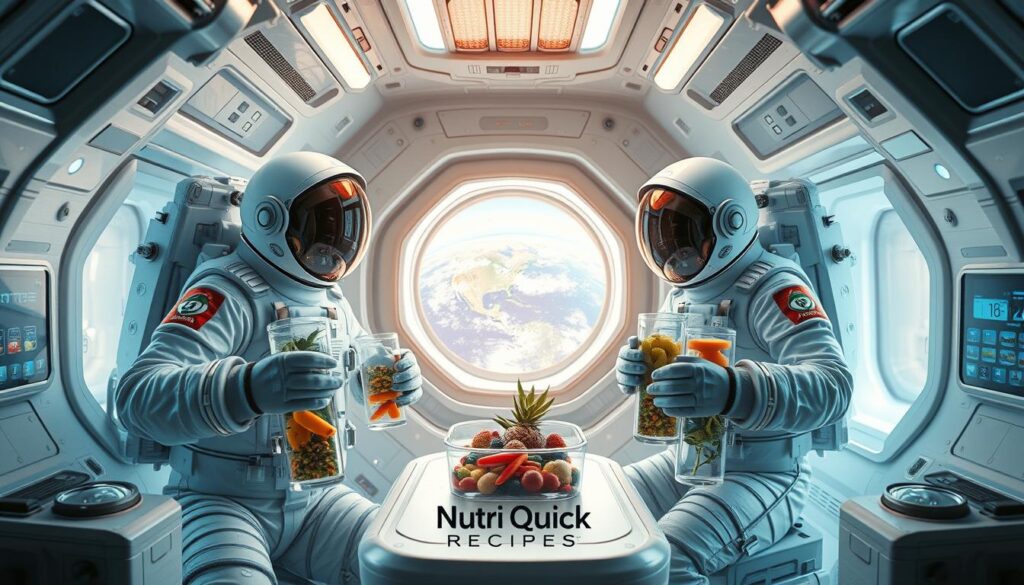
Hydrating Foods: Nutrient-Rich Options
Astronauts also eat hydrating foods full of nutrients. These foods keep their diet balanced and support their health. Fruits, vegetables, and broth-based soups are good examples. These foods help astronauts stay hydrated and healthy in space, enjoying space-friendly food options that taste great and are good for them5.
Challenges in Food Flavor and Textural Familiarity
Planning meals for space missions is tough, especially keeping food flavors and textures familiar. Food is key for astronauts’ health and happiness. In space, taste can change due to microgravity, so meals must be tasty and healthy.
Research shows microgravity can make food taste less flavorful6. This is because taste and smell are linked, and smell can change in space. To fix this, meals are carefully planned with special ingredients and cooking methods to boost flavor.
To make space meals more appealing, astronauts use herbs, spices, and marinate foods. They also choose high-flavor ingredients. Comfort foods that remind them of home are also important. These foods bring a sense of comfort and nostalgia, which is vital for their well-being.
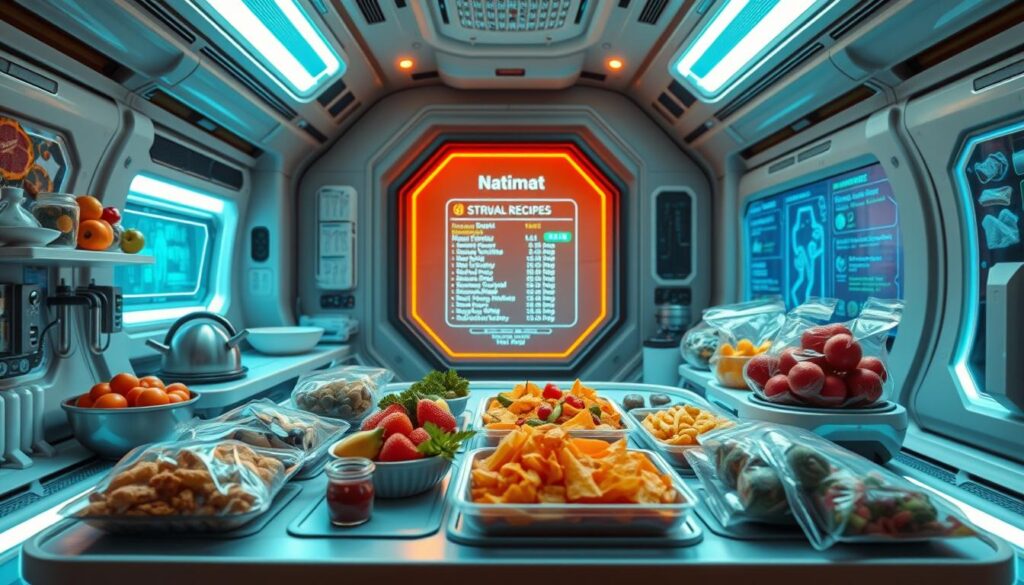
- Mac and cheese
- Chicken fajitas
- Beef stew
These foods are tasty and familiar, which is crucial for astronauts’ nutrition and happiness.
| Food | Calories | Protein |
|---|---|---|
| Mac and cheese | 500 | 20g |
| Chicken fajitas | 400 | 30g |
| Beef stew | 600 | 40g |
By adding these comfort foods to space meals, astronauts can enjoy nutritious, tasty, and familiar meals.
Natural Foods vs. Processed Foods
The debate between natural foods and processed foods is key for Healthy Eating in Space. Astronauts need a diet rich in nutrients as they spend more time in space. Thanks to space food technology, there are now more food options available.
Natural foods, like fruits and veggies, are packed with vitamins and minerals. They are often missing in processed foods, which are high in salt, sugar, and unhealthy fats. Eating whole foods can lower the risk of chronic diseases7.
The move towards natural foods in space food technology aims for healthier and sustainable food systems. This includes growing fresh produce in space using hydroponics and aeroponics. As the space program grows, we’ll see more creative ways to eat healthy in space8.
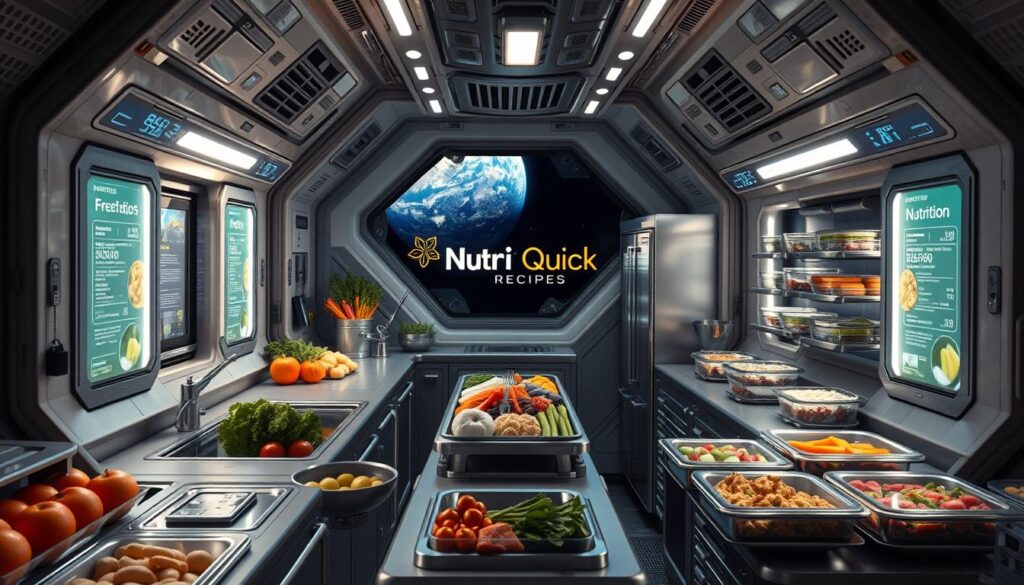
In summary, choosing natural foods over processed ones is the better option. With space food technology advancing, astronauts can now enjoy healthy meals. As we delve deeper into Healthy Eating in Space, focusing on natural foods and sustainable systems is crucial.
Growing Food in Space: A Look at Innovation
Space missions are getting longer and more common. This means we need food that can last a long time. Growing food in space is a new idea that could help. It uses hydroponics and aeroponics to grow plants in zero-gravity9.
NASA has been testing growing plants in space. They found some plants do really well up there. This could mean astronauts won’t have to rely on Earth for food as much. It also means they can eat a more varied and healthy diet9.
But growing food in space is more than just a food source. It’s also a chance for scientists to learn new things. They can study how plants grow in zero-gravity. This knowledge can help us grow better crops on Earth9.
| Method | Description |
|---|---|
| Hydroponics | A method of growing plants in a nutrient-rich solution rather than soil |
| Aeroponics | A method of growing plants in the air, with roots suspended in a nutrient-rich mist |
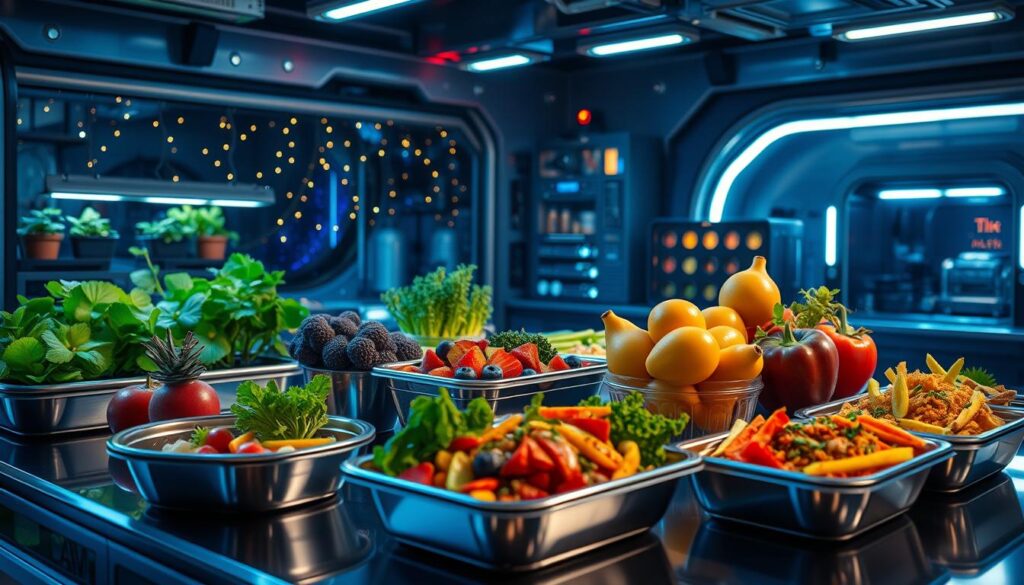
Psychological Aspects of Eating in Space
Eating in space is more than just getting food. It’s about feeling good too. Astronauts need astronaut nutrition and emotional support. Food helps celebrate special days and boosts everyone’s mood.
Studies show meals are key for astronauts’ mental health10. A good meal can reduce stress and anxiety. Astronauts’ meals are made to keep them healthy and sharp.
Food and Emotional Well-Being
Food deeply affects our feelings, especially for astronauts. A favorite dish can bring back memories of home. It’s a comfort that helps them cope with space life.
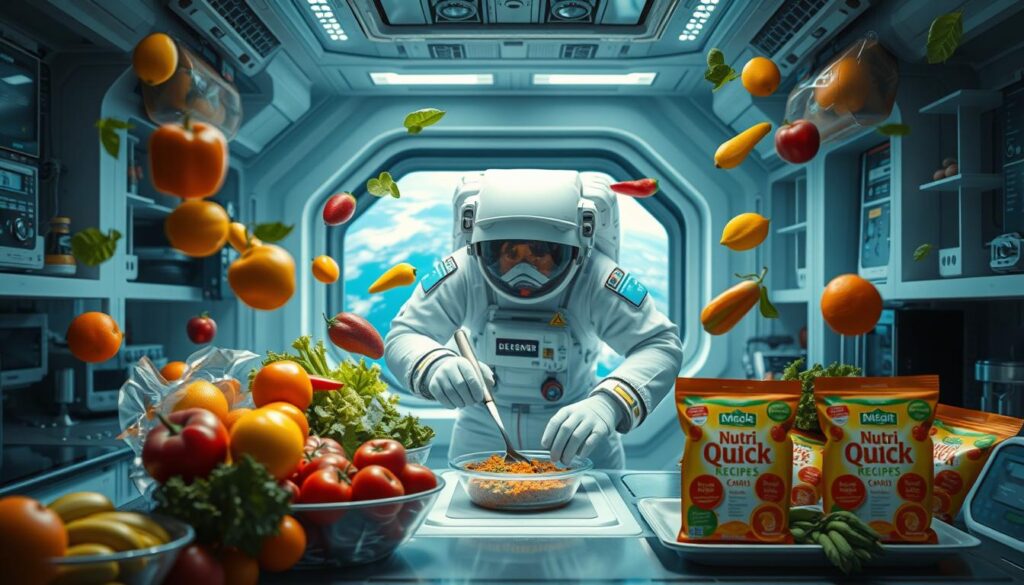
Celebrating Special Occasions with Space Meals
Special meals are vital for astronauts’ morale. They celebrate birthdays and holidays with special food. These meals are planned with care, considering outer space dietary needs.
In summary, eating in space is crucial for astronauts’ mental health. Good meals support their emotional well-being and keep their spirits high during long missions10.
Future of Healthy Eating in Space
Space missions are getting more advanced, making Healthy Eating in Space even more crucial. Now, astronauts can enjoy a variety of nutritious meals thanks to space food technology. Research shows that future space nutrition will focus on sustainable and efficient food systems11.
Innovative food production methods like hydroponics and aeroponics are key in space food technology. These methods allow for growing fresh produce in space. This ensures astronauts have a steady supply of healthy food. As we plan for future space exploration, prioritizing Healthy Eating in Space is vital for astronauts’ well-being and performance.
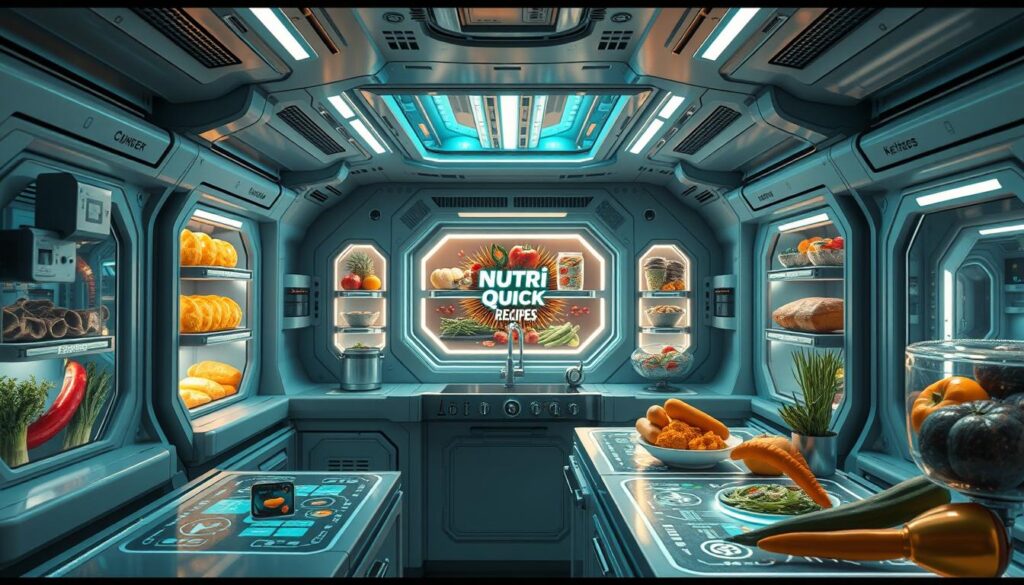
The goal for Mars missions is to create a sustainable food system. This will support astronauts on their journey to Mars. We need big steps in space food technology and understanding astronauts’ nutritional needs in space. By focusing on Healthy Eating in Space, we can make future space missions successful and keep astronauts healthy.
| Space Mission | Food System | Nutritional Needs |
|---|---|---|
| Mars Mission | Sustainable Food System | High-protein, high-calorie diet |
| International Space Station | Hydroponic and Aeroponic Systems | Balanced diet with fresh produce |
Success Stories: Astronauts and Their Favorite Meals
Astronauts face unique challenges when planning meals for space missions. They have to work with limited fresh ingredients and choose food that’s easy to eat in space. Sharing their favorite meals, astronauts show how important a good meal is for them in space12.
Comfort foods are a big part of astronauts’ meals to fight homesickness. They enjoy things like freeze-dried meats and thermostabilized veggies. These foods are chosen to taste like home and keep them nourished. As space travel advances, so does the need for special foods13.
The stories of astronauts and their meals remind us of the human side of space travel. As we plan for future space missions, the role of special foods will grow. New food technologies and options will help astronauts stay healthy and happy in space12.
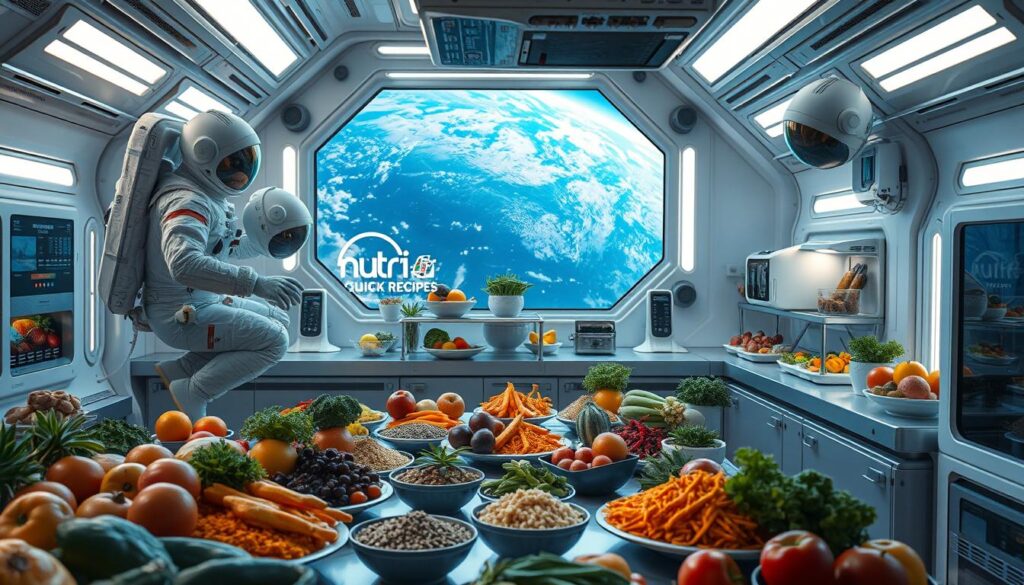
Conclusion: The Future of Nourishment Beyond Earth
Exploring space shows us how vital Healthy Eating in Space is. Astronaut nutrition is key for their health and work. New space tech makes nutrition for future missions more advanced.
Studies say a balanced diet is crucial for astronauts in space. Using natural foods and new ways to grow food, like hydroponics, is important. These steps help astronauts stay healthy on their missions.
Encouraging Healthy Eating Habits
We need to improve astronaut nutrition and promote healthy eating on Earth too. Supporting whole foods and sustainable food sources helps everyone. The success of space missions depends on our ability to innovate in food systems.
The Vision for Nutrition in Space
The future of nutrition in space is both exciting and challenging. New tech and food production methods will help astronauts eat well in space. As we explore more, Healthy Eating in Space will become even more important. It’s key for the success of future missions, as research shows.
FAQ
What is the importance of a balanced diet for astronauts in space?
A balanced diet is key for astronauts’ health in space. It helps prevent muscle and bone loss in zero gravity. This is especially important for long missions.
What are the unique nutritional challenges faced by astronauts in space?
Astronauts face special challenges in space, like losing muscle and bone. They need careful planning to get the right nutrients for their health.
How do astronauts prefer to eat in space?
Astronauts have limited food choices in space. They often eat freeze-dried meals. But they also enjoy fresh foods, like those grown in NASA’s Veggie experiment.
How are meal plans designed for space missions?
Designing meals for space missions is a team effort. Nutrition experts and chefs work together. They aim to make meals that are both healthy and tasty for astronauts.
Why is hydration important for astronauts in space?
Hydration is vital for astronauts in space. It keeps them healthy and performing well. Water reclamation systems help save water, and hydrating foods are also important.
How does microgravity affect food flavor and texture?
Microgravity changes how food tastes and feels. It can make meals less enjoyable. But, comfort foods and careful planning can improve the taste and feel of meals.
What are the benefits of natural foods for astronauts?
Natural foods are full of essential nutrients for astronauts. New methods are being developed to keep these nutrients in food. This supports healthy eating in space.
Can food be grown in space?
Yes, growing food in space is a promising solution. It could provide a sustainable food source for long missions. NASA’s experiments with plants show great promise.
What is the psychological impact of eating in space?
Eating in space is more than just for nutrition. It’s also about emotional well-being. Food helps celebrate special occasions and boosts morale through shared meals.
What does the future of healthy eating in space hold?
The future of eating in space is exciting and changing fast. New research and food technology are emerging. They aim to support Mars missions and beyond with sustainable and nutritious meals.
What are some of the favorite foods of astronauts in space?
Astronauts have shared their favorite foods. They include comfort foods that help them feel at home. These meals provide a sense of familiarity and comfort in space.
Source Links
- https://reason.com/2025/01/04/the-improbable-rise-of-maga-musk/ – The improbable rise of MAGA-Musk
- https://www.iheart.com/podcast/269-tiny-matters-90392988/episode/nearly-40-years-after-the-chornobyl-255712012/ – Nearly 40 years after the Chornobyl nuclear disaster, wildlife is thriving – Tiny Matters | iHeart
- https://www.atlantamagazine.com/homeandgarden/regardless-of-your-style-here-are-4-kitchen-remodels-worth-dreaming-about/ – Regardless of your style, here are 4 kitchen remodels worth dreaming about
- https://www.npr.org/2025/01/08/nx-s1-5247588/tilda-swinton-the-room-next-door – Tilda Swinton thinks about death and says you should, too
- https://news.duke-energy.com/releases/duke-energy-prepares-for-winter-storm-in-the-carolinas – Duke Energy prepares for winter storm in the Carolinas
- https://www.romper.com/life/lets-abolish-the-phrase-picky-eater – Let’s Abolish The Phrase “Picky Eater”
- https://apnews.com/article/college-football-commissioner-cfp-ffd1fb942d0ba0674152c4c2160ba428 – Penn State coach James Franklin calls for college football to have uniformity
- https://www.today.com/news/allison-holker-backlash-stephen-twitch-boss-drugs-rcna186760 – Allison Holker responds to criticism she’s ‘disgracing’ late husband tWitch’s name
- https://www.fool.com/investing/how-to-invest/stocks/how-to-invest-in-archer-aviation-stock/ – How to Invest in Archer Aviation (ACHR) | The Motley Fool
- https://www.yahoo.com/lifestyle/ate-louis-vuittons-caf-while-171627371.html – I ate at Louis Vuitton’s new café, and while I enjoyed ‘luxury snacking,’ it’s not a place I’m rushing to revisit
- https://www.cdc.gov/mmwr/volumes/74/wr/mm7401a1.htm?s_cid=mm7401a1_w – Expanded Recommendations for Use of Pneumococcal …
- https://www.miragenews.com/nasa-lander-tests-lunar-vacuum-for-sample-1387989/ – NASA Lander Tests Lunar Vacuum for Sample Collection
- https://www.yahoo.com/news/blue-origin-spacex-eye-major-144031190.html – Blue Origin, SpaceX eye major launches as space industry gears up for bumper 2025

